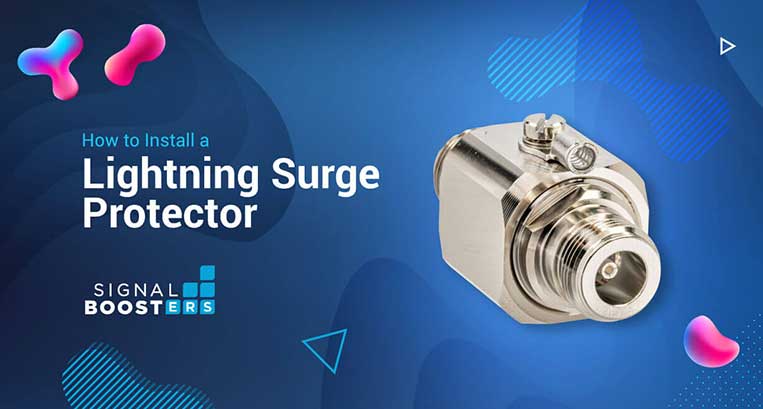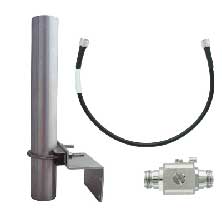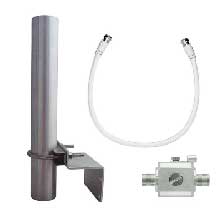How to Install a Lighting Surge Protector

So, you got a cell phone signal booster and are excited about finally eliminating poor cell phone signal inside your house. But, have you thought about how you'll protect your booster from lightning surges? After all, lightning occurs 20-25 million times per year. Your signal booster's antenna, installed on your roof and most likely attached to an antenna mast, is vulnerable to surges caused by nearby lightning.
To protect your investment, as well as your electrical equipment and property, we highly recommend antenna lightning surge protectors.
Keep reading to find out how important surge protectors are, and most importantly, how to install and properly ground them.
Take advantage of our system design and installation services. Learn more or call us for a free consultation: 1-800-969-8189.
What are Surges?
The National Electrical Manufacturers Association (NEMA) describes a surge, or transient, to be brief overvoltage spikes in an electrical circuit. Typically, they are very short, between 1-30 microseconds, and can reach up to 6,000 volts on a low-voltage consumer network. Depending on how powerful they are, they can destroy your electronic equipment or degrade their performance.
Power surges can originate inside your house due to high-powered appliances switching on and off or overloaded outlets, as well as outside your home due to direct or indirect lighting strikes or capacitor bank switching.
In the case of cell phone signal boosters, they are more vulnerable to lightning related voltage surges. The donor antenna is usually installed on the roof to capture the strongest 4G, LTE and 5G cell phone signals, as well as improve the line of sight between the antenna and the cell tower for optimal signal boost. Outdoor antenna systems consist of metal components, and metal is a great conductor of electricity. Thus, an antenna surge protection device is essential.
What is a Lightning Surge Protector?
As its name suggests, a lightning surge protector, also known as a surge arrestor or surge suppressor, is a device designed to protect electrical equipment and systems, such as your cell phone signal booster, from voltage spikes or surges caused by lightning.
How Does a Lightning Surge Protector Work?
In the event of voltage spikes, or transients, caused by nearby lightning strikes, a surge protector detects the excess energy and safely re-routs it through your grounding system, assuming you have a proper grounding system.
So, how does the surge protector know abnormal levels of energy are trying to invade your electrical system? Lightning surge protectors use tools, such as metal oxide varistors (MOV) or gas discharge tubes, that are triggered by voltage spikes. If you’re wondering, cell phone signal booster surge protectors, sometimes referred to as coaxial surge protectors, use the latter.
Gas discharge tubes contain a special gas trapped between two electrodes (a conductor that carries an electric current into non-metallic solids, liquids, or gasses). As long as normal levels of electricity are flowing through the surge protector arrester, the gas within the tube will remain dormant and a poor conductor of electricity.
Every gas discharge tube has a breakdown voltage or striking voltage point, which means that as soon as the gas tube senses a spike in voltage greater than its breakdown point, it will work its magic to dissipate the excess energy. How? The increased voltage ionizes the gas making it a conductor of electricity. The gas then re-routes the excess energy through your grounding system, while allowing normal levels of energy to flow through the signal boosters’ coaxial cables for uninterrupted service. Once the excess energy is fully dissipated, the gas becomes dormant again.
Gas discharge tubes can withstand multiple small surges and few large surges, so they don’t need to be replaced after every lightning surge. However, they will give out when undergoing overvoltage spikes much higher than what the device can handle, such as a direct lightning strike. At this point, the gas tube will need to be replaced.
How to Install and Ground Lightning Surge Protectors?
Installing and grounding a lightning surge protector is not a difficult job, it can be done in 4 easy steps. But, if you aren’t comfortable doing it yourself, don’t be afraid of calling an electrician.
Step 1: Make Sure you Have the Correct Equipment
First things first, before installing the lightning surge protector, make sure its impedance rating matches your signal boosters’ impedance rating of 50 or 75 Ohms. For example, if you have a 75 Ohm signal booster, use a 75 Ohm lightning surge protector. The same applies to the gas discharge tubes.
If you’re unsure of your signal booster's impedance rating, take a look at its connectors. Signal boosters with SMA or N-type connectors have an impedance rating of 50 Ohm, while boosters with F-type connectors have an impedance rating of 75 Ohm.
Step 2: Connect Lightning Surge Protector to Outside Antenna
The lightning surge protector must be installed between the outside antenna cable and the coax cable connected to the amplifier (also known as repeater or extender).
Some lightning surge protectors have double female connectors, while others have a female connector on one end and a male connector on the other. All of our lightning surge protectors are double female. Most donor antennas also have female connectors.
To connect your surge protector to the antenna, you’ll need a short jumper coax cable. One end will connect to the antenna, and the other to the surge protector.
Step 3: Connect Lightning Surge Protector to Amplifier
After connecting your lightning surge protector to the donor antenna, connect one end of the coax cable connect to the amplifier to the surge protector.
Since this cable is the one that runs inside your home, make sure the lightning surge protector is located outside your home, near the point of entry to mitigate fire hazards.
Step 4: Grounding Lightning Surge Protector
To ground the surge protector, the National Electric Code (NEC) suggests using a copper ground wire no smaller than 10 AWG.
Attach the cable to the lightning surge protector and use pliers to firmly crimp the top of the wire into the surge protector’s eyelet. If you are using insulated wire, make sure to strip about one inch of the insulation from both ends before installing the wire.
Use a wire that’s long enough so it reaches your grounding point, but short enough to avoid creating sharp bends or coiling the wire. Also, avoid using braided copper wire.
Attach the bottom of the grounding wire to your grounding point, and voila, you’re done.
These are some of the most common grounding point options:
- Ground Rod (Most Common)
- Metal Electrical Service Panel
- Water Pipe
- Metal Frame or Structure of a Building
Note: Electrical codes can vary between municipalities. Before grounding the surge protector, we recommend you check your local electrical code grounding rules.
Bonus Step: Grounding the Antenna Mast
Many people overlook this step and fail to realize its importance.
Due to their height and tendency to accumulate static, antenna masts are extremely vulnerable to direct and indirect lighting strikes. For that reason, it’s extremely important to ground them. If not properly grounded, the voltage spike will travel through the attached antenna and into your home.
In fact, the NEC mandates the grounding of all masts and antennas, such as signal booster antennas and cable tv antennas.
The grounding process is simple:
- Attach a wire no smaller than 10 AWG to the mast using a mast grounding clamp. If the mast is painted, scrape off some of the paint before attaching the wire.
- Run the wire down to your grounding rod (avoid creating sharp bends or coiling the wire).
- Use a ground lug to attach the wire to the grounding rod.
The grounded antenna mast acts as the first line of protection from powerful voltage spikes. If excess energy was to flow through the coax cables, the lighting surge protector will kick in and earth ground the excess energy.
Can a Surge Protector Work Without Grounding?
No.
Not grounding your lightning surge protector will have the same effect as not having a surge protector.
The gas discharge tube will detect the spike in voltage and try to dissipate it, but without the proper grounding system, the excess energy won’t have anywhere to go and will travel through the coax cables, the amplifier, the inside antenna, your outlet, and everything connected to your electrical system till the energy reaches the ground or dies out.
Your house’s grounding system could detect the surge and trip the circuit breaker or electrical panel, protecting your electrical equipment, but it won’t protect your cell phone signal booster.
Do Lightning Surge Protectors Protect Against Direct Lightning?
Unfortunately, no.
Lightning is extremely powerful. The National Weather Services states that a typical lightning flash contains about 300 million volts and about 30,000 amps.
If a lightning bolt was to directly hit your signal boosters’ donor antenna, it can easily over-power the lightning surge protector, even with the highest joule rated antenna surge protector. The best and cheapest way of protecting your equipment from a direct lightning strike would be by unplugging everything or turning off your power strips.
To fully protect your house, cell phone signal booster, and other electrical equipment from direct lightning strikes, it’s recommended to install a lightning rod.
Is it Necessary to Install a Lightning Surge Protector?
Since a lightning arrestor can’t actually protect my house from direct lightning strikes, are they even necessary? If you care about your electrical equipment, absolutely.
Homes can withstand a certain amount of energy flowing through their electrical system. A spike in voltage can and will damage the electrical equipment connected to your home's power grid. Worse, depending on how strong the electrical surge is, it can cause a fire.
While a lightning surge protector can’t protect your electrical equipment from direct lightning, it will protect your equipment from multiple surges, which will destroy and degrade your equipment. And since you are most likely to be affected by lightning surges than a direct lightning strike, your cell phone signal booster system will undergo damages a lot sooner without the proper care.
Note: Some signal booster manufactures void their warranty if a lightning surge protector is not used. Before deciding that it's not necessary to install a lighting surge protector, checkout your booster's manual or contact the manufacture.
How Can Lightning Surges Cause So Much Damage?
The answer is simple.
For your signal booster to work, it needs to be plugged into a power supply. If your home does not have grounded outlets or a proper grounding system, the electrical current will travel through the wall outlet damaging your TVs, game consoles, appliances, desktop computers, WiFi routers, modems, and any electrical equipment in its path.
High voltage energy entering an unprotected house's electrical outlet, can cause a spark in the wiring, which can short-circuit the power system and start a fire.
Usually, the number of prongs on your outlets will easily tell you if they are grounded. 2-prong outlets are usually non-grounded, while 3-prong outlets are. Some houses even have ground fault circuit interrupters (GFCI), the outlets with test and reset buttons, which trips as soon as an electrical imbalance is detected. However, the number of prongs won't tell you if your electrical system is functioning properly.
If you want to make sure your ground, neutral, and hot wires are working properly to mitigate lightning surge damages, you can purchase a receptacle tester or outlet tester from Amazon, or anywhere that sells electrical equipment.
Signal Booster Lightning Surge Protector
Bolton Technical 50 Ohm Essential Installer Kit
Overview:
- Improves Lifespan of your Signal Booster System
- Works with all 50 Ohm Systems
- Replaceable Gas Tube
- Kit includes a Surge Protector, a 2-foot Jumper Cable and a 10-inch Mounting Pole
- High Quality, Durable Build
- Grounding Kits Sold Separately
Bolton Technical 75 Ohm Essential Installer Kit
Overview:
- Protects Cell Booster from Lightning Surges
- Works with all 75 Ohm Systems
- Replaceable Gas Tube
- Kit includes a Surge Protector, a 2-foot Jumper Cable and a 10-inch Mounting Pole
- High Quality, Durable Build
- Grounding Kits Sold Separately
Contact Us
Signal Boosters is a leading provider of cell phone signal boosters for homes, vehicles, and commercial buildings. We specialize in consumer-friendly kits as well as customized RF systems for cellular, public safety two-way radio, DAS, and WiFi.
We’re here to assist with any issues you might be experiencing with poor cell service. Contact us today, or call us at 1-800-470-6777.
Interested in Learning More? Check Out Our Cellular Info Hub / WiFi Info Hub
Table of Contents

Recent Posts






